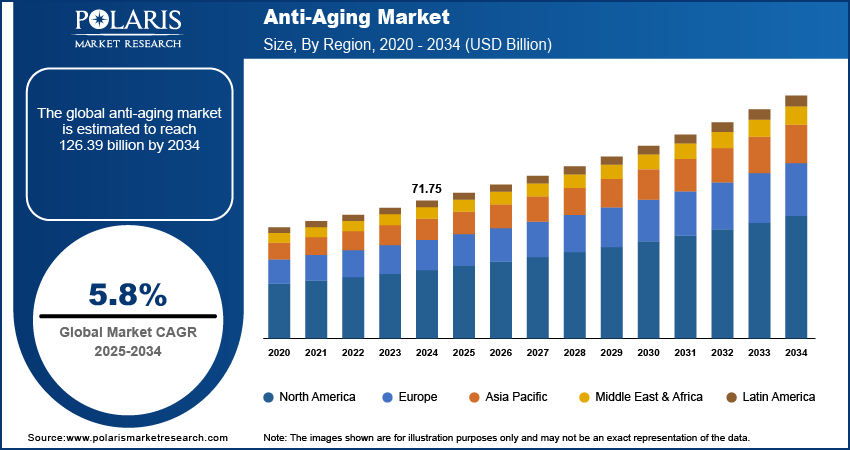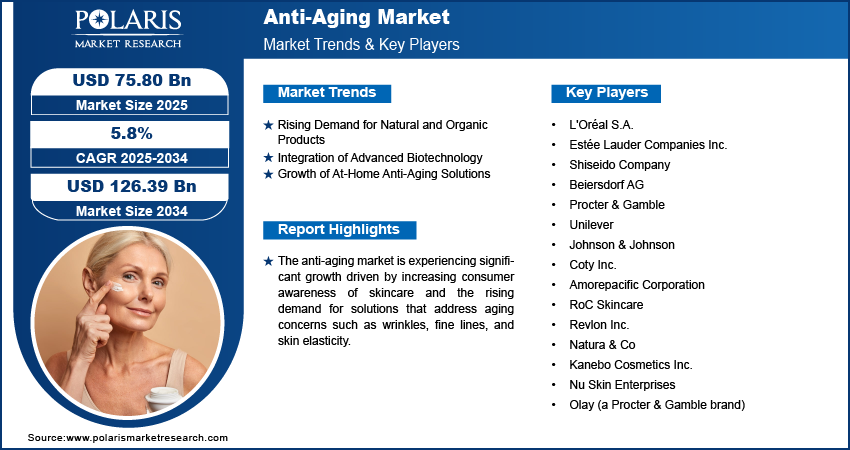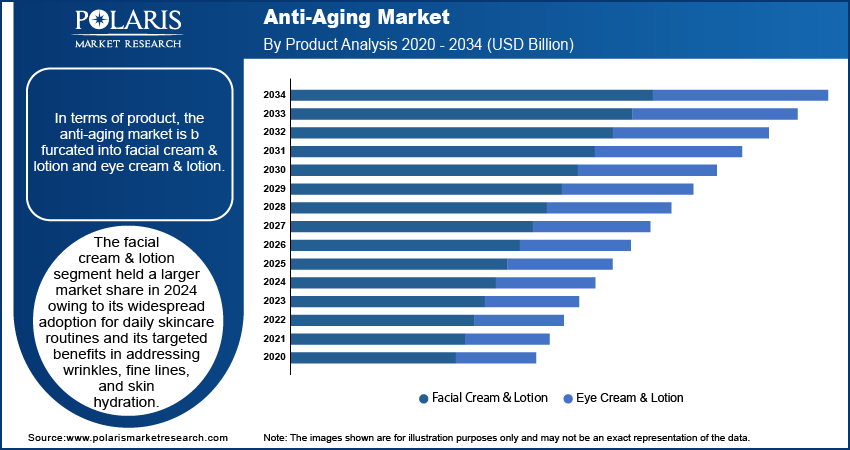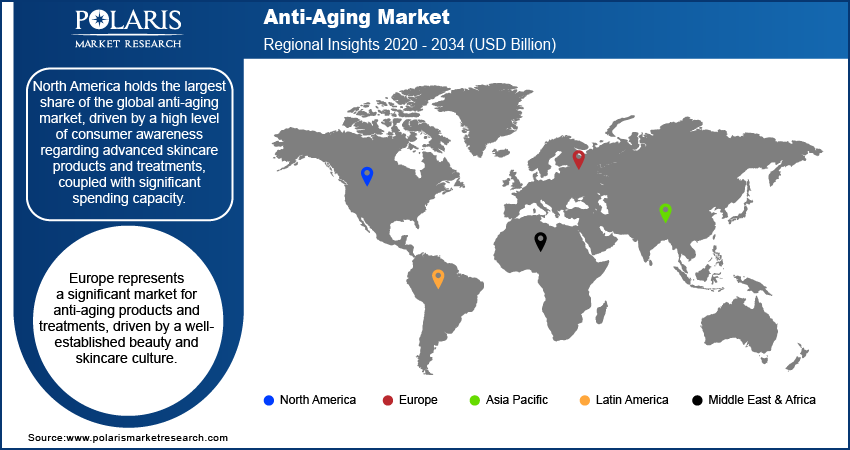
Anti-Aging Market Size, Share, Trends, Industry Analysis Report
: By Product (Facial Cream & Lotion and Eye Cream & Lotion), Distribution Channel, Application, and Region (North America, Europe, Asia Pacific, Latin America, and Middle East & Africa) – Market Forecast, 2025–2034
- Published Date:Jan-2025
- Pages: 119
- Format: PDF
- Report ID: PM1702
- Base Year: 2024
- Historical Data: 2020-2023
Anti-Aging Market Overview
The anti-aging market size was valued at USD 71.75 billion in 2024. The market is projected to grow from USD 75.80 billion in 2025 to USD 126.39 billion by 2034, exhibiting a CAGR of 5.8% during 2025–2034.
The anti-aging market encompasses products, services, and treatments designed to prevent or reduce the signs of aging in individuals. This market includes skincare products, cosmetic procedures, and anti-aging supplements. Increasing consumer awareness of personal care, advancements in skincare technologies, and a growing aging population seeking youthful appearances drive the anti-aging market development. Trends shaping the market are the rising demand for natural and organic products, the incorporation of biotechnology in anti-aging solutions, and the increasing adoption of personalized skincare regimens. Additionally, digital platforms and e-commerce are facilitating wider access to anti-aging products and information.

To Understand More About this Research: Request a Free Sample Report
Anti-Aging Market Dynamics
Rising Demand for Natural and Organic Products
Consumers are increasingly choosing natural and organic anti-aging products because they are more aware of the potential risks of synthetic chemicals. This has led manufacturers to focus on plant-based ingredients and eco-friendly sourcing practices. Products with natural antioxidants like vitamin C, plant-derived hyaluronic acid, and herbal extracts are becoming more popular. As a result, the rising demand for natural and organic options is driving the growth of the anti-aging market.
Integration of Advanced Biotechnology
Biotechnology is playing a pivotal role in the evolution of anti-aging treatments, particularly in personalized and medical-grade skincare solutions. Techniques such as DNA-based skin analysis are enabling brands to create customized formulations that cater to individual skin profiles. Additionally, peptide technology and stem cell research are driving innovations in anti-aging therapies, improving their efficacy in reducing wrinkles and boosting skin elasticity. Thus, the integration of advanced biotechnology to introduce innovative anti-aging products or treatments is expected to boost the anti-aging market growth during the forecast period.
Growth of At-Home Anti-Aging Solutions
The demand for at-home anti-aging devices and solutions is growing rapidly due to their convenience and new technological improvements. Tools like LED light therapy masks, microcurrent devices, and ultrasonic skin scrubbers help consumers achieve professional-level results from the comfort of their own homes, without needing to visit clinics. Social media has played a big role in this trend, with influencers and dermatologists sharing tutorials and reviews, which has encouraged more people to try these devices. As a result, the rising popularity of at-home anti-aging products is expected to drive the demand for anti-aging solutions from 2025 to 2034.

Anti-Aging Market Segment Insights
Anti-Aging Market Outlook – Product-Based Insights
The anti-aging market, by product, is segmented into facial cream & lotion and eye cream & lotion. The facial cream & lotion segment held a larger market share in 2024 owing to its widespread adoption for daily skincare routines and its targeted benefits in addressing wrinkles, fine lines, and skin hydration. These products are widely marketed as essential components of anti-aging regimens, often containing active ingredients such as retinol, hyaluronic acid, and peptides. The segment’s dominance is also supported by extensive availability across retail and online channels, coupled with a strong consumer preference for multifunctional products combining anti-aging benefits with sun protection and moisturization.
The eye cream & lotion segment is registering the highest growth rate, fueled by increasing awareness of specialized care for sensitive skin areas around the eyes. Rising consumer concerns over issues such as puffiness, dark circles, and crow’s feet, which often develop early in the aging process, boost the demand for eye creams and lotions. Advanced formulations featuring caffeine, ceramides, and collagen are gaining traction in this category. Moreover, marketing strategies emphasizing visible, short-term results have significantly contributed to the segment’s rapid expansion.
Anti-Aging Market Assessment – Distribution Channel-Based Insights
The anti-aging market, by distribution channel, is segmented into hypermarket & supermarket and specialty store. The hypermarket & supermarket distribution channel holds a larger market share in the market, driven by the convenience of accessing a wide variety of products under one roof and competitive pricing strategies. These retail outlets offer consumers the ability to explore multiple brands and formulations in person, enhancing their shopping experience. Promotional campaigns, in-store discounts, and loyalty programs further contribute to the dominance of this segment, making it a preferred choice for purchasing premium and mass-market anti-aging products.

The specialty store segment is experiencing a higher growth rate, fueled by the increasing demand for expert consultation and exclusive product availability. Specialty stores often provide personalized services, such as skin analysis and product recommendations, which appeal to consumers seeking tailored solutions. These outlets are particularly known for offering high-end, niche, and dermatologist-recommended products that are not typically available in general retail channels. Additionally, the rising trend of clean and organic beauty products aligns well with the offerings in specialty stores, further propelling their growth.
Anti-Aging Market Outlook – Application Insights
The anti-aging market, by application, is segmented into anti-wrinkle treatment, anti-pigmentation, skin resurfacing, and other applications. The anti-wrinkle treatment segment holds the largest market share, driven by widespread consumer demand for solutions targeting visible signs of aging such as fine lines and wrinkles. Anti-wrinkle products, including creams, serums, and in-clinic treatments such as Botox, have become the cornerstone of anti-aging regimens due to their effectiveness in promoting smoother, firmer skin. The ongoing consumer interest in both preventive and corrective treatments has supported the segment's dominance, making it a significant contributor to the anti-aging market revenues.
The anti-pigmentation segment is registering the highest growth rate owing to the increasing awareness of skin discoloration and age spots, particularly among aging populations. Products targeting hyperpigmentation are gaining traction as consumers seek solutions to even out skin tone and reduce the appearance of dark spots caused by sun exposure and aging. The rise of targeted formulations, often enriched with ingredients such as vitamin C, retinoids, and hydroquinone, is boosting this segment’s growth. Additionally, the trend toward personalized skincare, where products are tailored to address pigmentation concerns, is further fueling the expansion of the anti-pigmentation segment.
Anti-Aging Market Regional Insights
By region, the study provides anti-aging market insights into North America, Europe, Asia Pacific, Latin America, and the Middle East & Africa. North America holds the largest market share, driven by a high level of consumer awareness regarding advanced skincare products and treatments, coupled with significant spending capacity. The region benefits from a strong presence of key market players, extensive availability of innovative anti-aging solutions, and well-established dermatology and aesthetic treatment facilities. Additionally, rising demand for minimally invasive cosmetic procedures and increasing adoption of personalized skincare regimens fuel the market growth in North America. Factors such as an aging population and growing interest in preventive skincare contribute to the region's dominance in the global market.
Europe represents a significant market for anti-aging products and treatments, driven by a well-established beauty and skincare culture. The demand for anti-aging products and services is fueled by increasing consumer interest in high-quality, science-backed formulations and natural ingredients. Countries such as Germany, France, Italy, and the UK are key contributors to the market, supported by strong retail networks and the presence of prominent global and regional brands. Furthermore, rising awareness of noninvasive cosmetic surgery and the growing popularity of luxury skincare products continue to boost the anti-aging market expansion in Europe.
Asia Pacific is emerging as one of the fastest-growing regions in the anti-aging market, propelled by a large and rapidly aging population and increasing disposable income. Consumers in countries such as China, Japan, and South Korea show high demand for innovative and multifunctional skincare products. The region also benefits from the popularity of traditional beauty practices combined with modern anti-aging technologies. Additionally, the influence of using K-beauty products and J-beauty trends has significantly shaped consumer preferences, encouraging the adoption of targeted solutions for anti-aging concerns.

Anti-Aging Market – Key Market Players and Competitive Insights
Key players active in the anti-aging market include L'Oréal S.A., Estée Lauder Companies Inc., Shiseido Company, Beiersdorf AG, Procter & Gamble, Unilever, Johnson & Johnson, Coty Inc., Amorepacific Corporation, RoC Skincare, Revlon Inc., Natura & Co, Kanebo Cosmetics Inc., Nu Skin Enterprises, and Olay (a Procter & Gamble brand). These companies are consistently investing in product development and leveraging advanced technologies to address a wide range of aging concerns, such as wrinkles, pigmentation, and skin elasticity. Many of these brands have also introduced natural and organic product lines to align with changing consumer preferences.
The competitive landscape in the anti-aging market is marked by a combination of innovation, branding strategies, and product differentiation. Established players such as L'Oréal and Estée Lauder are capitalizing on their extensive R&D capabilities to introduce science-driven solutions, while regional brands such as Amorepacific and Shiseido leverage cultural influences and unique formulations to cater to specific demographics. Digital marketing, including influencer collaborations and social media campaigns, plays a critical role in increasing product visibility and consumer engagement across global markets.
The anti-aging market insights reveal that companies are increasingly adopting sustainability practices, such as the use of eco-friendly packaging and sustainable ingredients, to appeal to environmentally conscious consumers. Additionally, the expansion of e-commerce platforms has enabled brands to reach wider audiences, particularly in emerging markets. Strategic partnerships with dermatologists and the introduction of personalized skincare solutions further highlight the competitive efforts to strengthen consumer trust and brand loyalty in a rapidly evolving market.
L’Oréal is a global player in the anti-aging market, offering a wide range of skincare products under brands such as Lancôme, Vichy, and SkinCeuticals. The company focuses on integrating advanced dermatological research into its product lines, targeting various aging concerns.
Estée Lauder is well-known for its diverse portfolio of anti-aging solutions through brands such as Clinique, Estée Lauder, and La Mer. The company emphasizes the use of high-performance ingredients and innovative formulations to cater to aging concerns.
Key Companies in Anti-Aging Market
- L'Oréal S.A.
- Estée Lauder Companies Inc.
- Shiseido Company
- Beiersdorf AG
- Procter & Gamble
- Unilever
- Johnson & Johnson
- Coty Inc.
- Amorepacific Corporation
- RoC Skincare
- Revlon Inc.
- Natura & Co
- Kanebo Cosmetics Inc.
- Nu Skin Enterprises
- Olay (a Procter & Gamble brand)
Anti-Aging Industry Developments
- In October 2024, Estée Lauder announced a partnership with a biotech firm to enhance its research into personalized skincare, showcasing its commitment to technological advancements and customization in product development.
- In September 2024, L’Oréal launched a new anti-aging serum under its Lancôme brand, incorporating biofermented ingredients to address skin firmness and hydration, reflecting its focus on innovation and sustainable practices.
- February 2024: Rejuvenate Bio published a report detailing an experiment that demonstrated that partial reprogramming mediated by Gene therapy prolongs lifespan and reverses age-related changes in aged mice.
- September 2023: AbbVie company reported Positive topline findings from the second of three Phase 3 clinical trials assessing onabotulinumtoxinA (BOTOX® Cosmetic) for the treatment of moderate to severe platysma.
Anti-Aging Market Segmentation
By Product Outlook
- Facial Cream & Lotion
- Eye Cream & Lotion
By Distribution Channel Outlook
- Hypermarket & Supermarket
- Specialty Store
By Application Outlook
- Anti-Wrinkle Treatment
- Anti-Pigmentation
- Skin Resurfacing
- Other Applications
By Regional Outlook
- North America
- US
- Canada
- Europe
- Germany
- France
- UK
- Italy
- Spain
- Netherlands
- Russia
- Rest of Europe
- Asia Pacific
- China
- Japan
- India
- Malaysia
- South Korea
- Indonesia
- Australia
- Vietnam
- Rest of Asia Pacific
- Middle East & Africa
- Saudi Arabia
- UAE
- Israel
- South Africa
- Rest of Middle East & Africa
- Latin America
- Mexico
- Brazil
- Argentina
- Rest of Latin America
Anti-Aging Market Report Scope
|
Report Attributes |
Details |
|
Market Size Value in 2024 |
USD 71.75 billion |
|
Market Size Value in 2025 |
USD 75.80 billion |
|
Revenue Forecast by 2034 |
USD 126.39 billion |
|
CAGR |
5.8% from 2025 to 2034 |
|
Base Year |
2024 |
|
Historical Data |
2020–2023 |
|
Forecast Period |
2025–2034 |
|
Quantitative Units |
Revenue in USD Billion and CAGR from 2025 to 2034 |
|
Report Coverage |
Revenue Forecast, Market Competitive Landscape, Growth Factors, and Trends |
|
Segments Covered |
|
|
Regional Scope |
|
|
Competitive Landscape |
|
|
Report Format |
|
|
Customization |
Report customization as per your requirements with respect to countries, regions, and segmentation. |
How is the report valuable for an organization?
Workflow/Innovation Strategy
The anti-aging market has been broadly segmented on the basis of product, distribution Channel, and application. Moreover, the study provides the reader with a detailed understanding of the different segments at the global and regional levels.
Growth/Marketing Strategy
The growth and marketing strategy in the anti-aging market focuses heavily on product innovation, consumer education, and personalization. Companies are investing in advanced research and development to introduce new, effective formulations that target specific aging concerns. Digital marketing, including influencer partnerships and social media campaigns, plays a crucial role in reaching younger and tech-savvy consumers. Additionally, brands are increasingly offering personalized skincare solutions based on individual skin profiles, tapping into the growing trend of customization. Companies also emphasize sustainability by using eco-friendly packaging and sourcing ingredients responsibly to appeal to environmentally conscious buyers.
FAQ's
The market size was valued at USD 71.75 billion in 2024 and is projected to grow to USD 126.39 billion by 2034.
The market is projected to register a CAGR of 5.8% during 2025–2034.
North America had the largest share of the market in 2024.
A few key players active in the anti-aging market are L'Oréal S.A., Estée Lauder Companies Inc., Shiseido Company, Beiersdorf AG, Procter & Gamble, Unilever, Johnson & Johnson, Coty Inc., Amorepacific Corporation, RoC Skincare, Revlon Inc., Natura & Co, Kanebo Cosmetics Inc., Nu Skin Enterprises, and Olay (a Procter & Gamble brand).
The facial cream & lotion segment accounted for a larger share of the market in 2024.
The hypermarket & supermarket segment accounted for a larger share of the market in 2024.
Anti-aging practices, products, and treatments focus on preventing, slowing, or reversing the visible effects of aging on the skin and body. This includes reducing the appearance of wrinkles, fine lines, and age spots, improving skin elasticity, and promoting overall skin health. Anti-aging solutions often involve the use of skincare products, supplements, and cosmetic procedures designed to enhance youthful appearance and maintain vitality. The concept can also extend to lifestyle changes, such as adopting healthier habits, a balanced diet, and avoiding excessive sun exposure to mitigate the aging process
A few key trends in the anti-aging market are described below: Increasing Demand for Natural and Organic Products: Consumers prefer anti-aging products with natural ingredients, driven by concerns about skin health and sustainability. Advancements in Biotechnology: The integration of biotechnology in skincare, such as DNA-based skin analysis and peptide technology, is improving the effectiveness of anti-aging products. Rising Focus on Personalized Skincare: Customized anti-aging solutions based on individual skin profiles are gaining popularity, offering more targeted and effective treatments. Growth of At-Home Anti-Aging Devices: The demand for home-use devices such as LED masks and microcurrent tools is rising, providing consumers with professional-grade results at home.
A new company entering the anti-aging market must focus on developing personalized skincare solutions, as customization is becoming increasingly important to consumers. By leveraging advanced technologies such as skin analysis tools and incorporating data-driven recommendations, the company could offer tailored anti-aging products. Additionally, emphasizing sustainability through eco-friendly packaging and natural, clean ingredients could help attract environmentally conscious buyers. Investing in effective digital marketing strategies, including influencer partnerships and social media engagement, would also be crucial for building brand awareness. Finally, offering affordable yet high-quality products with proven results can help the company differentiate itself in a competitive market.
Companies manufacturing, distributing, or purchasing anti-aging and related products; consulting firms; and treatment centers must buy the report.
